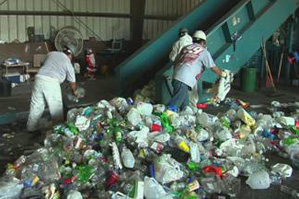Plastics get a new lease on life as electricity generators

Here are two problems our planet needs help with:
1. Getting rid of all the trash we pile on top of it
2. Making electricity for us in a healthy, sustainable way
Mechanical and Industrial engineering professor Yiannis Levendis has it covered. He recently filed a patent for a reactor that efficiently turns plastics and other polymer-based waste products into electricity…or, if you’re into this sort of thing, carbon nanotubes.
One day several years ago, Levendis set a Styrofoam cup on fire. As you might expect, it burned quickly, creating a thick black cloud of smoke and leaving behind a tiny pile of soot and tar. Polymers like polystyrene are long chains of carbon and other atoms, arranged in different unique patterns depending on the material. Each atom is connected by a chemical bond, which stores potential energy. When he burned the cup, those bonds broke quickly and the energy was released as heat. The black soot was simply the new embodiment of those same carbon atoms, now taking various forms including polycyclic aromatic hydrocarbons, or PAHs, the pollutants released during traditional waste incineration.
Each year, the United states uses 330 million barrels of petroleum to produce 30 million tons of post-consumer plastics, Levendis told me. What if we could take those two numbers and roll them together so that the waste plastics  we produce become the fuel we need to heat our homes and power our lights? Levendis realized the possibility was there, simply because of the energy stored between the carbon atoms. If he could figure out a way to turn that energy into something useful without generating the black smoke cloud, he would be on the right track.*
we produce become the fuel we need to heat our homes and power our lights? Levendis realized the possibility was there, simply because of the energy stored between the carbon atoms. If he could figure out a way to turn that energy into something useful without generating the black smoke cloud, he would be on the right track.*
The word “burn” implies the presence of oxygen in the environment, since combustion is the high-heat reaction between oxygen and a fuel (be it a wooden log, petroleum, or a Styrofoam cup). But if you heat that solid fuel to very high temperatures in an inert atmosphere such as nitrogen, you merely get the gaseous version of the fuel. No combustion takes place because there is no oxygen around to react with. The process is called pyrolytic gasification and it is the central feature of Levendis’ reactor.
 Like many other creatures, the reactor eats carbon-based materials and releases a stream of gas. The gas is then mixed with air, ignited and burned into a beautiful blue/purple flame – no black smoke, no pile of soot. Since each type of plastic contains a unique mix of atoms, the ultimate gas produced will contain different levels of things like methane, ethane or pentane. The technology for turning these gases into light or electricity has been around for a while, as evidenced by all the old gas lights on Beacon Hill, and elsewhere. Our aversion to such technology stems from our unwanted reliance on finite fuel supplies. But there’s a whole bunch of plastic in the world that simply gets thrown into a landfill or burned, generating pollutants.
Like many other creatures, the reactor eats carbon-based materials and releases a stream of gas. The gas is then mixed with air, ignited and burned into a beautiful blue/purple flame – no black smoke, no pile of soot. Since each type of plastic contains a unique mix of atoms, the ultimate gas produced will contain different levels of things like methane, ethane or pentane. The technology for turning these gases into light or electricity has been around for a while, as evidenced by all the old gas lights on Beacon Hill, and elsewhere. Our aversion to such technology stems from our unwanted reliance on finite fuel supplies. But there’s a whole bunch of plastic in the world that simply gets thrown into a landfill or burned, generating pollutants.
In the last decade, the cost of natural gas has fluctuated between $2.5 and $14 per gigajoule of internal energy. Levendis’ current reactor uses a feeding mechanism that requires the use of post-consumer plastic pellets which are not exactly cheap. With this design, the cost is about $10 per gigajoule. But he and his team are working on new feeding methods, which would allow them to directly use a pallet of plastic bottles, cups, bags, you name it. This design would bring the cost down to $1 per gigajoule. And, Levendis reminded me, none of these numbers incorporate the value of using wastes instead of virgin fuel and thus cleaning up the environment.
*At this point I need to insert a small disclaimer: Levendis was doing all this theorizing with two people I actually knew quite well. I worked at a small start-up company called Nano-C before coming to Northeastern. I distinctly remember standing in the office back at The C, as we affectionately called it, talking to Henning Richter about a project he was working on with a Northeastern professor, turning trash into carbon nanotubes. I thought that was pretty darn intriguing, but I never learned more until I met Levendis last month. The person who founded Nano-C, Jack Howard, was a chemical engineer at MIT for many years and before his passing in 2007, he was critical to the theoretical process that would allow the trio (Levendis, Righter and Howard), along with graduate student Chuanwei Zhuo, tourn waste plastics into energy and carbon nanotubes.






